Sarah Emsley's Blog, page 39
October 18, 2013
What Edith Wharton Tells Us About The Way We Live Now
Part Eight in a series celebrating the 100th Anniversary of Edith Wharton’s novel The Custom of the Country.
Today’s the day! The first edition of The Custom of the Country was published 100 years ago today, on October 18, 1913. Happy anniversary to the book Edith Wharton called her “Big Novel,” her “magnum opus.”
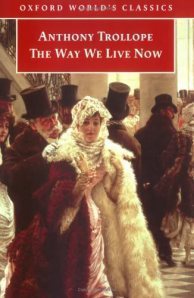 George Packer wrote earlier this year about the experience of reading Anthony Trollope’s novel The Way We Live Now and finding New York society reflected in Trollope’s London: “Greed is eternal, but when the money flows as plentifully upward as in London circa 1873 or New York circa 2013, and is as unequally distributed, it becomes a moral toxin, saturates the world of culture, makes relationships more competitive, turns desire into the pursuit of status, replaces solid things with mirages.” The same toxic effect appears in the New York circa 1913 world of Edith Wharton’s novel The Custom of the Country, as money motivates both the beautiful Undine Spragg and the self-made businessman Elmer Moffatt to climb higher and higher in pursuit of the things they want, with little regard for the effect of their actions on other people.
George Packer wrote earlier this year about the experience of reading Anthony Trollope’s novel The Way We Live Now and finding New York society reflected in Trollope’s London: “Greed is eternal, but when the money flows as plentifully upward as in London circa 1873 or New York circa 2013, and is as unequally distributed, it becomes a moral toxin, saturates the world of culture, makes relationships more competitive, turns desire into the pursuit of status, replaces solid things with mirages.” The same toxic effect appears in the New York circa 1913 world of Edith Wharton’s novel The Custom of the Country, as money motivates both the beautiful Undine Spragg and the self-made businessman Elmer Moffatt to climb higher and higher in pursuit of the things they want, with little regard for the effect of their actions on other people.
In a wonderful new collection of essays on Wharton’s life and works, Edith Wharton in Context, editor Laura Rattray highlights the “breathtakingly contemporary relevance” of The Custom of the Country “in the burning embers of the economic meltdown post 2008.” Wharton’s criticism of materialism, cultural ignorance, and the dangers of extreme versions of Emersonian self-reliance is more relevant than ever.
Undine Spragg understands competition, and knows that beauty helps her win, but she doesn’t understand the culture she seeks to enter and dominate. She makes no effort to understand people, tradition, art, or architecture. She hurts her New York husband, Ralph Marvell, when she has her jewellery, including her sapphire and diamond engagement ring, reset. With no thought of the meaning of these “family relics, kept unchanged through several generations,” Undine changes them to suit herself, utterly “unconscious of the wound she inflicted in destroying the identity of the jewels” (Chapter 15). Later, her French husband, Raymond de Chelles, is shocked to find that she thinks he should sell the family estate so they have more money to spend. As Cecilia Macheski points out in her essay on “Architecture,” Undine consistently “misreads the architecture that she inhabits.”
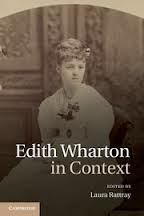 This collection of thirty-three essays, on topics ranging from publication history, contemporary reviews, obituaries, biographies, and stage and screen adaptations, to gender, race, imperialism, naturalism, World War I, and the Great Depression, plus a chronology that places Wharton in her cultural and historical context, is a fascinating guide to the life and writings of a prolific, learned, energetic, and enigmatic woman who wrote some of the most enduring fiction in American literature.
This collection of thirty-three essays, on topics ranging from publication history, contemporary reviews, obituaries, biographies, and stage and screen adaptations, to gender, race, imperialism, naturalism, World War I, and the Great Depression, plus a chronology that places Wharton in her cultural and historical context, is a fascinating guide to the life and writings of a prolific, learned, energetic, and enigmatic woman who wrote some of the most enduring fiction in American literature.
It’s in The Custom of the Country that Rattray finds an apt metaphor for the importance of reading Wharton in context: in this novel, as elsewhere in Wharton’s writing, Rattray says in her essay on “Contextual Revisions,” “to deny context is to deny meaning,” just as Undine “violates context” when she has the Marvell jewels reset and arranges for the sale of the de Chelles family tapestries. (Her power does have its limits—she can’t quite pull off the sale of the entire chateau.) Context, writes Rattray, “is the Goliath glue that binds together the writer’s social, economic, literary, aesthetic, historical whole.”
In an essay on “Social Traditions,” Adam Jabbur makes the excellent point that while Wharton’s novels are often “Satirical and biting,” “they retain at least the shadow of possibility—an image, however unclear, of a future that has not lost everything of the past.” I can’t agree, however, with his subsequent argument that Undine is not Wharton’s “primary object of condemnation.” While Wharton has a complex understanding of her heroine’s character and motivation, and is even at times sympathetic to her, she is also very clear about the devastating effects of Undine’s ambitions on other people, especially Ralph. (I’ve written about Undine’s response to Ralph’s suicide in an essay for Persuasions On-Line.) The Marvell family and other members of the New York elite may be susceptible to attacks from ambitious outsiders and “doomed to extinction,” as Ralph prophesies early on (Chapter 5), but Undine is ultimately to blame for the callous way she manipulates her family, her friends, and her husbands.
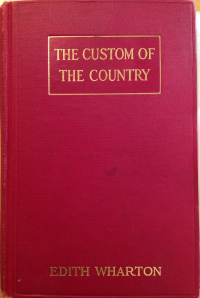
First edition of The Custom of the Country
Through her portrait of Undine, as Linda Costanzo Cahir argues in “Wharton and the American Romantics,” Wharton raises questions about Ralph Waldo Emerson’s philosophy of self-reliance: “Fully unconstrained by traditional standards of conduct and devoid of any homage to custom, she, arguably, carries Emerson’s creed to its dangerously logical conclusion, and, consequently, dramatizes what Wharton understands to be the inherent flaw in Emerson’s doctrine. At its extreme, Emersonian self-reliance can not only mortally harm others, but also carry its practitioner to a world fully void of humanity, decency, and, ironically, divinity.”
Undine Spragg of Apex () vows to do whatever it takes to get what she wants. She tells Ralph early in their courtship that what she wants and expects is “everything!” (Chapter 7), yet in the end, she feels “there were other things she might want if she knew about them” (Chapter 46). As I’ve suggested in my introduction to the Broadview edition of the novel, “she does not want enough. Undine may want all the things that signify social success, but her ‘everything’ does not include love, and this is the reason why her search is doomed to fail.” Edith Wharton in Context helps us understand the way Wharton lived then, which helps us understand what her writing tells us about life both then and now.
Next in this series: Part Nine: Edith Wharton’s Portrait of a Lady—Mr. Popple’s portraits and Undine’s powers
My other posts on The Custom of the Country:
Part One: How I Discovered The Custom of the Country
Part Three: “I’ll never try anything again till I try New York”
Part Four: Undine Spragg as the Empress Josephine
Part Five: Marriage, Divorce, and “diversified elements of misery”
Part Six: “Diamonds are a Girl’s Best Friend”
That moment when you’re revising obsessively and it feels like “an attack of scrupulosis”…: On revising The Custom of the Country
Happy 100th Anniversary to Edith Wharton’s The Custom of the Country! The first installment of the novel was published in Scribner’s Magazine in January 1913.
Writing with “dogged obstinacy”: In the summer of 1911, Edith Wharton was “digging away” at her “Big Novel,” The Custom of the Country, wondering if “dogged obstinacy” could “replace freedom & inspiration.”
“The books were too valuable to be taken down”: On Undine Spragg’s treatment of her son Paul in the last chapter of The Custom of the Country, and Paul’s experience of nightmarish library in which the books can never be read, and no one ever writes.
French Fact and American Fiction: Wharton’s use of place names in The Custom of the Country.


October 9, 2013
Among the Janeites – a review
 What are Janeites, and who wants to be one of them, or spend time among them? George Saintsbury invented the word to describe Jane Austen’s fans in 1894, and in the decades since, the word has been both embraced and rejected by Austen’s readers. In Among the Janeites: A Journey Through the World of Jane Austen Fandom, Deborah Yaffe explores what it means to be a reader so devoted to Austen that the experience is transformative. Focusing on the North American Janeite and the history of the Jane Austen Society of North America, she profiles members who dress in period costume, make pilgrimages to Austen-related sites in England, read Austen’s novels for therapeutic reasons and debate ways of interpreting them, and blog about the diverse contemporary manifestations of a fascination with Austen’s works and her world.
What are Janeites, and who wants to be one of them, or spend time among them? George Saintsbury invented the word to describe Jane Austen’s fans in 1894, and in the decades since, the word has been both embraced and rejected by Austen’s readers. In Among the Janeites: A Journey Through the World of Jane Austen Fandom, Deborah Yaffe explores what it means to be a reader so devoted to Austen that the experience is transformative. Focusing on the North American Janeite and the history of the Jane Austen Society of North America, she profiles members who dress in period costume, make pilgrimages to Austen-related sites in England, read Austen’s novels for therapeutic reasons and debate ways of interpreting them, and blog about the diverse contemporary manifestations of a fascination with Austen’s works and her world.
It’s especially interesting to read about the creativity that Austen has inspired. What is it about Austen, Yaffe asks, that makes her readers think they can be writers, too? She speculates that the proliferation of prequels, sequels, and other variations on Austen’s works may have something to do with the idea that Austen “seems at first glance an unintimidating figure — the country clergyman’s daughter, without much money or formal education, who traveled little, socialized mostly with relatives and neighbors, and wrote about the stuff of ordinary life, the family conflicts and love stories that we’ve all lived through ourselves.” She imagines Janeites thinking, “If she could write like that, surely we can too!”
Jane Austen inspires people to write, to interpret and reimagine her novels, and to research the Regency period. She inspires people to recreate the clothing, accessories, customs, and food of the time, but she also inspires them to change their lives. Yaffe’s story of Christine Shih’s discovery of Austen’s powerful heroines, in a chapter on “Austen Therapy,” is particularly moving: it was from Elizabeth Bennet and Fanny Price that Shih absorbed the confidence and strength she needed to survive a difficult childhood. If Austen’s heroines can be courageous and confident, surely we can too.
Not all readers of Jane Austen are happy to identify with the term “Janeite,” because it can imply a kind of uncritical adoration and a familiarity with a great writer so removed from us in time and literary achievement that we can never quite justify being on a first-name basis. But if being a Janeite means being inspired by the strong women Austen wrote about, and being inspired to write, research, and create, then the experience promises to be a rewarding one. As Maggie Sullivan of Austenblog says in Yaffe’s chapter on “Jane.net,” “Janeite-ville is a big tent,” with room for many different kinds of Austen readers.
If you’ve ever wondered what it’s like to attend a JASNA AGM, reading Among the Janeites will give you a good introduction to the experience, minus the details of the academic papers. Yaffe talks about some aspects of the academic side of things in a chapter on “The Knowledge Business,” but sometimes the conference papers seem to get in the way of her story, as when she attends “one last breakout session” featuring “yet another college professor” before heading for her hotel room to get ready for the banquet and ball. Leaving out what the critics and scholars say is a big omission, because serious academic work is always central to the conferences, but it’s one easily 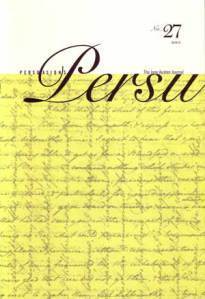 remedied if you read JASNA’s two peer-reviewed journals, Persuasions and Persuasions On-Line, alongside Yaffe’s book. Both journals include many of the papers presented at every AGM.
remedied if you read JASNA’s two peer-reviewed journals, Persuasions and Persuasions On-Line, alongside Yaffe’s book. Both journals include many of the papers presented at every AGM.
If you often attend the AGMs and sometimes miss one, as I did this year — much to my regret, because this year’s focus was 200 years of Pride and Prejudice — then reading this book will re-introduce you to old friends and acquaintances, tell you their stories with wit, humour, and respect, and give you the illusion that, for a few hours at least, you’re back among the Janeites. I can’t wait to read the conference papers on Pride and Prejudice, so I can hear what my fellow Janeites were saying this year in Minneapolis.
I’m grateful to Deborah Yaffe for telling the fascinating, often very touching stories of some of Austen’s most devoted readers, and I’m grateful to her for what she says about Austen’s own life story. She reminds us that while the country clergyman’s daughter may seem unintimidating, “it’s the very ordinariness of Austen’s life that is the most intimidating thing about her: nothing explains her achievement except the ineffable quality of her mind, and who among us can lay claim to that?” Whether we think of her as “Jane” or as “Austen,” we need to remember just how extraordinary her achievement is.
Related links:
Deborah Yaffe’s website and Facebook page
Jane Austen Society of North America
Persuasions and Persuasions On-Line
JASNA 2013 AGM: Pride and Prejudice


October 2, 2013
“We really do inhabit the novels”: An Interview with Elaine Bander, President of JASNA Canada
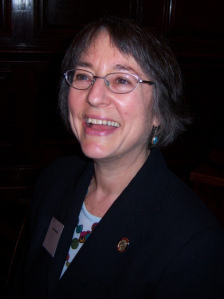
Elaine Bander
Elaine Bander will be visiting Halifax on October 25th to give a lecture called “Jane Austen’s Fanny Price and Lord Nelson: Rethinking the National Hero(ine).” This exciting event is co-sponsored by the Jane Austen Society of North America (JASNA) and the Department of English at Dalhousie University, and the talk will be held in the Marion McCain Arts and Social Sciences Building (6135 University Avenue, Halifax, Nova Scotia), Room 1198, at 3:45pm.
Elaine is President of JASNA Canada, President of The Burney Society, and Coordinator of the 2014 JASNA AGM, which will be held in Montréal, and will focus on Mansfield Park. She is an excellent speaker and we’re very much looking forward to both her visit and her lecture. She graciously agreed to answer a few questions about her research and her abiding interest in Austen’s novels.
What’s the most memorable thing you’ve done this year to celebrate the 200th anniversary of the publication of Pride and Prejudice?
Ha! I baked a Pride and Prejudice birthday cake for the JASNA-Montreal folks. We decided on short notice to have a birthday celebration at my house. I am an excellent free-range cook, but not much of a baker. I baked a quite acceptable yellow butter cake and iced it and EVEN DECORATED IT to look like a copy of Pride and Prejudice (sort of). Someone asked me for the recipe. Success!
What’s your perspective on why Austen’s novels are so popular with twenty-first century readers?
I think Austen’s novels ought to be popular with everyone, everywhere, because Austen took such care to use careful, non-dating language, to avoid cultural clichés, and to observe psychology truthfully, but there’s no denying that she’s hit the big time in 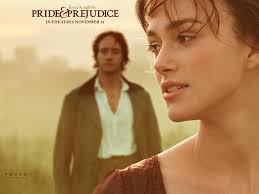 recent decades. I’m afraid I have to attribute her new success to multimedia: films, TV, pop cultural icons. This probably brings new readers to Austen. Perhaps they are looking for the romance, or quaint formal manners, or pretty décor and floaty dresses, that were so attractive in the films. I am confident, however, that anyone who actually reads the novels stays for brilliant writing and memorable characters. Austen’s novels are particularly brilliant at involving each careful reader in the same experiences as her heroines. We really do inhabit the novels. But as for the sudden popularity — that has to be due to the films, the pop-culture gateway. The novels haven’t changed.
recent decades. I’m afraid I have to attribute her new success to multimedia: films, TV, pop cultural icons. This probably brings new readers to Austen. Perhaps they are looking for the romance, or quaint formal manners, or pretty décor and floaty dresses, that were so attractive in the films. I am confident, however, that anyone who actually reads the novels stays for brilliant writing and memorable characters. Austen’s novels are particularly brilliant at involving each careful reader in the same experiences as her heroines. We really do inhabit the novels. But as for the sudden popularity — that has to be due to the films, the pop-culture gateway. The novels haven’t changed.
When did you first discover Austen, and which novel did you read first?
Ah, confession: When I was about twelve, a friend gave me a copy of Pride and Prejudice to read. She knew I liked to read 19th-century novels and thought I’d enjoy this one. I 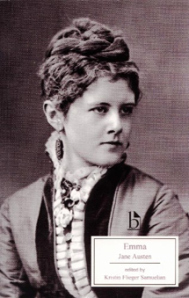 couldn’t get past the first chapter. The dialogue between Mr. and Mrs. Bennet — can you believe it? — seemed so choppy and stilted to me. “Prejudice” had led me to expect a Brontë-esque tail of racial discrimination and rebellion. No Jane Austen for me! Then, in my third year as an undergraduate, I took a 19th-century novel survey course, and read Emma. Revelation! What brilliance! I never looked back. In the next two years I read everything Austen wrote, and then began a PhD for which I eventually wrote a dissertation on Austen.
couldn’t get past the first chapter. The dialogue between Mr. and Mrs. Bennet — can you believe it? — seemed so choppy and stilted to me. “Prejudice” had led me to expect a Brontë-esque tail of racial discrimination and rebellion. No Jane Austen for me! Then, in my third year as an undergraduate, I took a 19th-century novel survey course, and read Emma. Revelation! What brilliance! I never looked back. In the next two years I read everything Austen wrote, and then began a PhD for which I eventually wrote a dissertation on Austen.
You’ve been very active in The Burney Society for many years, as well as in JASNA. Tell us a bit about the intersections between your work on Jane Austen and your work on Frances Burney. Which of Burney’s novels would you recommend to an Austen fan who hasn’t yet discovered her, and why?

I think I’m the only person alive who read a Burney novel before she read an Austen one. In my first year at McGill, living in the Royal Victoria College, I poked around the RVC library for fun reading. One of the novels I read was Burney’s first novel, Evelina, the book that made her famous in her 20s. As a consequence, I’ve tended to read Austen in relation to the books that she read, the works of the late 18th century. I’ve always been fascinated by how Austen both pays great respect to Burney, her literary mother, but also transforms the novel form that she inherited from Burney. Those transformations provide real insight into Austen’s interests and aims. She is always writing against readers’ expectations.

Most people suggest that readers should start with Evelina: it’s light, bright and sparkling, a fun book, and, like Pride and Prejudice, a Cinderella tale. But Pride and Prejudice is Austen’s least typical novel. I think Camilla meant more to her — her name appears on the subscription list! — but I hate to recommend Camilla. It’s 5 volumes long, and many people find Burney’s repeated deferral of resolution maddening. After all, the heroine and hero get engaged halfway through: what can possibly go wrong? But I find it fascinating, especially in relation to Mansfield Park, which I believe Camilla at least partly inspired.
In 2011 you were chosen to participate in JASNA’s International Visitor Program, which provides funding for a six-week trip to Chawton to work on an Austen-related project, while also working with the staff at Jane Austen’s House Museum, Chawton House Library, and/or St. Nicholas Church. What was your research project, and what was it like to work in Chawton for six weeks? Did you feel that the experience helped strengthen connections between the North American and British Jane Austen Societies?
The year (2011) when I was the IVP, it was just for a month, but that felt about right to me. Nobody much wanted me to do any work for them — in the end, my only contribution to the Chawton community was to help prune the roses in the rose garden at CHL. The staff were short-handed and the roses were clearly desperate! I loved the experience of living in the country, Jane Austen’s country. Like Jane, I had to walk a mile into Alton to do any chores, buy food, stamps or newspapers. Or like Jane, I could choose the lovely walk across the fields, woods and sheep meadows to Upper Farringdon. Jane walked there regularly to visit a friend. I walked to visit the excellent Rose & Crown and admire the pretty village.
On my last weekend, I continued over further fields and hanger woods to Selborne, up onto Selborne Common and down the Zig Zag path to visit the Gilbert White House. Because I stopped for tea afterwards, I missed the last bus back and had to walk home: four miles each way.
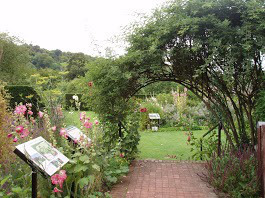
Gilbert White’s Garden
I really cherished being part of the Chawton community for a month: dropping in to the Jane Austen House Museum, gossiping with CHL staff, watching the bell-ringers practice in St. Nicholas’s on Monday evenings (and being invited to pull a bell!), occasionally speaking with the tourists who were always walking up the drive to the church, meeting people on the walk into Alton, keeping track of the livestock, waking to the sounds of the rescue hens, the horses next door, the sheep nearby, the wood pigeons cooing…. When I returned for four days this summer, I was greeted like a friend. It’s a wonderful program, and certainly builds a trans-Atlantic community!
But of course my main reason for being there was the Library. I had proposed to research material for compiling “A Common-Place Book for Fanny Price.” I view Fanny as Austen’s only really intellectual heroine. She is a reader. The only Austen character who is said to keep a commonplace book (a collection of extracts from reading) is Mary Bennet, so clearly Austen didn’t think much of the practice, but I wanted to find source material that might have inspired Fanny’s values and courage. I found more than I bargained for. You’ll hear about some of that.
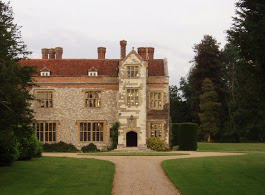
Chawton House Library
You’re the Coordinator for next year’s JASNA AGM, October 10-12, 2014, entitled “
Mansfield Park
in Montréal: Contexts, Conventions, and Controversies.” What are some of the highlights of the program that we can look forward to, and in what ways will the  AGM help us move beyond the so-called “Fanny Wars,” in which readers argue (often vehemently, as you know!) about the perceived strengths and weaknesses of Austen’s most controversial heroine, Fanny Price?
AGM help us move beyond the so-called “Fanny Wars,” in which readers argue (often vehemently, as you know!) about the perceived strengths and weaknesses of Austen’s most controversial heroine, Fanny Price?
Well, first of all, I hope our conference will inspire people to return to the novel and read, without prejudice, what Austen wrote. She is so careful to describe the behaviour and the values of all of her characters. If people read carefully and fairly — as each Austen novel invites us to do — they must sympathise with Fanny’s struggle for self-knowledge and moral courage. That doesn’t mean seeing her as a little goody two shoes. Austen doesn’t do perfect.

Robert Miles
We are hoping for a reader’s AGM, asking people to return, critically, to the text, but we’re also planning a lot of fun activities. We’ve commissioned a comic play about rehearsing Lovers’ Vows at Mansfield. We will have Glee Singing and Star-Gazing and walks in the Wilderness and a wonderful Ball. We have great plenary speakers, all new to JASNA: Robert Miles will give us a thought-provoking talk about Austen’s values. Lynn Festa will provide a dynamic discourse on MP and noise. And Patrick Stokes, descendant of Charles Austen, will leave us in stitches while he tells as about the Georgian Royal Navy.

Lynn Festa
We’ve worked closely with the hotel’s executive chef to prepare a menus that both references the novel and uses our best seasonal terroir. And our tote bags will be very, very special.
Do you have a favourite quotation from Mansfield Park?
Interesting question! Not really. Mansfield Park is particularly rich in entire, almost allegorical scenes rather than single speeches.
But I frequently cite Fanny’s remark to Mr. Crawford when he’s walking with her in Portsmouth and asks her to be his moral guide: “‘We have all a better guide in ourselves, if we would attend to it, than any other person can be’” (Vol. 3, Ch. 11). I think this statement is key to all of Jane Austen’s works.
~~~~~
Thanks, Elaine! Now, dear readers, it’s your turn. Do you agree that what Fanny says is key to Austen’s works? What are your favourite quotations from Mansfield Park, and do you have any other comments or questions for Elaine?
We hope to see you in Halifax on October 25, 2013 — or in Montréal in October 2014!
P.S. You can read the Call for Papers for the 2014 AGM in Montréal here. The deadline for proposals is October 15th, so make haste, make haste.
P.P.S. JASNA’s International Visitor Program is now accepting applications for 2014, and you can read all about the program and the application process here. Write a persuasive proposal, and you, too, could live and work in Chawton for a few weeks.


September 26, 2013
“Trading Up”: Wharton’s Influence on Candace Bushnell and Julian Fellowes
Part Seven in a series celebrating the 100th Anniversary of Edith Wharton’s novel The Custom of the Country.
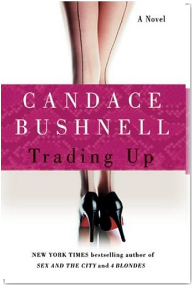 Just as there’s a direct line from Wharton’s Undine Spragg to Madonna’s “Material Girl,” there’s a direct line from Undine to the heroine of Candace Bushnell’s 2003 novel Trading Up, Janey Wilcox. Janey is beautiful, ambitious, and determined to get money and status in New York through trading one man for another. Her husband Selden (shades of Lawrence Selden in The House of Mirth), thinks at one point that “Ever since they had returned from their honeymoon, she’d been attacking New York with the zeal of a mountain climber determined to reach the highest summit, with him, it seemed, relegated to a Sherpa in cummerbund and black tie.”
Just as there’s a direct line from Wharton’s Undine Spragg to Madonna’s “Material Girl,” there’s a direct line from Undine to the heroine of Candace Bushnell’s 2003 novel Trading Up, Janey Wilcox. Janey is beautiful, ambitious, and determined to get money and status in New York through trading one man for another. Her husband Selden (shades of Lawrence Selden in The House of Mirth), thinks at one point that “Ever since they had returned from their honeymoon, she’d been attacking New York with the zeal of a mountain climber determined to reach the highest summit, with him, it seemed, relegated to a Sherpa in cummerbund and black tie.”
Bushnell acknowledges the link to Wharton when Janey tells Selden The Custom of the Country should be a movie. She’s been trying to persuade her former lover Comstock Dibble, head of Parador Pictures, that he’s the right man to make it: “‘It’s never been done before and he’d be good at it.’” I agree with her that it would make a great movie. I would love to see Undine as a film star—it just might be “the one part she was really made for” (of course I’m quoting her thoughts from the novel out of context here, but the line fits my own purpose so well!).
At one point there were plans for a film adaptation, written and directed by Christopher Hampton, but the film never materialized. In 1995, Entertainment Weekly advertized the adaptation: “Midwestern beauty Undine Spragg (Uma Thurman) and her parents (Sally Field, Paul Newman) move to turn-of-the-century New York City to take society by storm. But will a youthful indiscretion—namely her ex-husband (Robert De Niro)—spoil Undine’s plans?”
While there is as yet no film version of The Custom of the Country, Wharton’s “Big Novel” has influenced Julian Fellowes and the creation of Downton Abbey, as well as 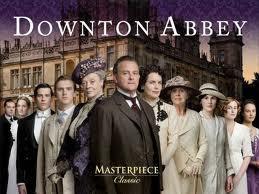 Candace Bushnell and her New York heroines. Fellowes says that after discovering The House of Mirth, “I moved on from Lily Bart to The Custom of the Country and it is quite true that I felt this was my book; that the novel was talking to me in a most extreme and immediate way. I think it’s a remarkable piece of writing. In Undine Spragg, Wharton has created an anti-heroine absolutely in the same rank as Becky Sharp, Scarlet O’Hara, or Lizzy Eustace. Undine has no values except ambition, greed and desire, and yet through the miracle of Wharton’s writing, you are on her side. That’s what’s so extraordinary about the book…. All of this was a tremendous inspiration to me. I decided, largely because of her work, that it was time I wrote something. Because of Edith Wharton and the old saying ‘write what you know,’ I decided to write what I knew, not to try and find a more interesting story than my own but to write about my own past and the world I’d grown up in.”
Candace Bushnell and her New York heroines. Fellowes says that after discovering The House of Mirth, “I moved on from Lily Bart to The Custom of the Country and it is quite true that I felt this was my book; that the novel was talking to me in a most extreme and immediate way. I think it’s a remarkable piece of writing. In Undine Spragg, Wharton has created an anti-heroine absolutely in the same rank as Becky Sharp, Scarlet O’Hara, or Lizzy Eustace. Undine has no values except ambition, greed and desire, and yet through the miracle of Wharton’s writing, you are on her side. That’s what’s so extraordinary about the book…. All of this was a tremendous inspiration to me. I decided, largely because of her work, that it was time I wrote something. Because of Edith Wharton and the old saying ‘write what you know,’ I decided to write what I knew, not to try and find a more interesting story than my own but to write about my own past and the world I’d grown up in.”
What do you think of the connections between Wharton’s novels and Downton Abbey? Do you see Undine’s influence on the series, and on Bushnell’s heroines (and anti-heroines)?
Next in this series: Part Eight: What Edith Wharton Tells Us About The Way We Live Now—The Custom of the Country and Edith Wharton in Context, edited by Laura Rattray
My other posts on The Custom of the Country:
Part One: How I Discovered The Custom of the Country
Part Three: “I’ll never try anything again till I try New York”
Part Four: Undine Spragg as the Empress Josephine
Part Five: Marriage, Divorce, and “diversified elements of misery”
Part Six: “Diamonds are a Girl’s Best Friend”
That moment when you’re revising obsessively and it feels like “an attack of scrupulosis”…: On revising The Custom of the Country
Happy 100th Anniversary to Edith Wharton’s The Custom of the Country! The first installment of the novel was published in Scribner’s Magazine in January 1913.
Writing with “dogged obstinacy”: In the summer of 1911, Edith Wharton was “digging away” at her “Big Novel,” The Custom of the Country, wondering if “dogged obstinacy” could “replace freedom & inspiration.”
“The books were too valuable to be taken down”: On Undine Spragg’s treatment of her son Paul in the last chapter of The Custom of the Country, and Paul’s experience of nightmarish library in which the books can never be read, and no one ever writes.
French Fact and American Fiction: Wharton’s use of place names in The Custom of the Country.


September 12, 2013
“Diamonds are a Girl’s Best Friend”
Part Six in a series celebrating the 100th Anniversary of Edith Wharton’s novel The Custom of the Country.
Undine Spragg is never happy in her marriages, though she continues to be optimistic that she’ll eventually find the right man. The Custom of the Country is a novel of serial marriage, and serial divorce. Like Lorelei Lee, the heroine of Gentlemen Prefer Blondes (1925) by Anita Loos, Undine thinks that overall, American men are better than “French gentlemen,” although for a while, Paris does seem “devine” to both women. There are striking parallels between Lorelei and Undine, as Lorelei similarly travels from one city to the next, and from America to Europe, looking for happiness in status and material possessions.
Marilyn Monroe famously starred as Lorelei, the material girl living in a material world, for whom “Diamonds are a Girl’s Best Friend,” in the 1953 movie Gentlemen Prefer Blondes. (If you follow the link and watch the clip from the song, tell me if the ”decorative” women on the chandelier make you think of George Saunders’s story “The Semplica-Girl Diaries.” And if you haven’t read the story yet — I recommend it highly.)
In Loos’s novel, Lorelei concludes: “So I really think that American gentlemen are the best after all, because kissing your hand may make you feel very very good but a diamond and safire bracelet lasts forever” (Chapter 4).
Wharton praised Gentlemen Prefer Blondes as “the great American Novel,” and her biographer R.W.B. Lewis says she was pleased to see elements of Undine’s character in Loos’s heroine. I wonder what she would think of the progression from Lorelei to Marilyn Monroe to Madonna’s “Material Girl” video.
For further reading:
Edith Wharton: A Biography, by R.W.B. Lewis (New York: Harper & Row, 1975).
Gentlemen Prefer Blondes, by Anita Loos (New York: Penguin, 1998). (Chapter 4 of Gentlemen Prefer Blondes, “Paris is Devine,” also appears in the appendices in my Broadview edition of The Custom of the Country.)
Next in this series: Part Seven: “Trading Up”: Wharton’s Influence on Candace Bushnell and Julian Fellowes—Undine as a film star?
My other posts on The Custom of the Country:
Part One: How I Discovered The Custom of the Country
Part Three: “I’ll never try anything again till I try New York”
Part Four: Undine Spragg as the Empress Josephine
Part Five: Marriage, Divorce, and “diversified elements of misery”
That moment when you’re revising obsessively and it feels like “an attack of scrupulosis”…: On revising The Custom of the Country
Happy 100th Anniversary to Edith Wharton’s The Custom of the Country! The first installment of the novel was published in Scribner’s Magazine in January 1913.
Writing with “dogged obstinacy”: In the summer of 1911, Edith Wharton was “digging away” at her “Big Novel,” The Custom of the Country, wondering if “dogged obstinacy” could “replace freedom & inspiration.”
“The books were too valuable to be taken down”: On Undine Spragg’s treatment of her son Paul in the last chapter of The Custom of the Country, and Paul’s experience of nightmarish library in which the books can never be read, and no one ever writes.
French Fact and American Fiction: Wharton’s use of place names in The Custom of the Country.


September 5, 2013
Marriage, Divorce, and “diversified elements of misery”
Part Five in a series celebrating the 100th Anniversary of Edith Wharton’s novel The Custom of the Country.
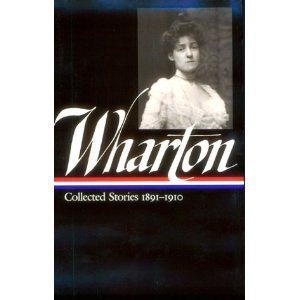 Edith Wharton was fascinated with marriage and divorce as subjects for fiction. She began work on The Custom of the Country in 1907, but set it aside to write two other novels. Ethan Frome was published in 1911 and The Reef was published in 1912; both explore questions about marriage and desire. In her short story “The Other Two” (1904), the heroine’s third husband ends up in an awkward situation having tea with the first two husbands.
Edith Wharton was fascinated with marriage and divorce as subjects for fiction. She began work on The Custom of the Country in 1907, but set it aside to write two other novels. Ethan Frome was published in 1911 and The Reef was published in 1912; both explore questions about marriage and desire. In her short story “The Other Two” (1904), the heroine’s third husband ends up in an awkward situation having tea with the first two husbands.
The Custom of the Country is an extended meditation on a similar situation, as each of Undine’s husbands comes to terms with her previous marriages. The novel was published in 1913, the same year that Wharton divorced her husband of twenty-eight years. Teddy Wharton was from an old Boston family, and he had graduated from Harvard (barely), but he had very little sympathy for his wife’s literary and cultural interests.
A few years before her divorce, Edith Wharton wrote to her friend John Hugh Smith about marriage as a literary subject: “I wonder, among all the tangles of this mortal coil, which one contains tighter knots to undo, & consequently suggests more tugging, & pain, & diversified elements of misery, than the marriage tie—& which, consequently, is more ‘made to the hand’ of the psychologist and the dramatist?” (12 February 1909).
Here’s what the protagonist in “The Other Two,” Waythorn, thinks about his marriage: “He had fancied that a woman can shed her past like a man. But now he saw that Alice was bound to hers both by the circumstances which forced her into continued relation with it, and by the traces it had left on her nature. With grim irony Waythorn compared himself to a member of a syndicate. He held so many shares in his wife’s personality and his predecessors were his partners in the business.” Marriage and divorce as more business than passion—the custom of the country.
For further reading:
Collected Stories, 1891-1910, by Edith Wharton (New York: Library of America, 2001).
The Letters of Edith Wharton, ed. R.W.B. Lewis and Nancy Lewis (New York: Macmillan, 1988).
My other posts on The Custom of the Country:
Part One: How I Discovered The Custom of the Country
Part Three: “I’ll never try anything again till I try New York”
Part Four: Undine Spragg as the Empress Josephine
That moment when you’re revising obsessively and it feels like “an attack of scrupulosis”…: On revising The Custom of the Country
Happy 100th Anniversary to Edith Wharton’s The Custom of the Country! The first installment of the novel was published in Scribner’s Magazine in January 1913.
Writing with “dogged obstinacy”: In the summer of 1911, Edith Wharton was “digging away” at her “Big Novel,” The Custom of the Country, wondering if “dogged obstinacy” could “replace freedom & inspiration.”
“The books were too valuable to be taken down”: On Undine Spragg’s treatment of her son Paul in the last chapter of The Custom of the Country, and Paul’s experience of nightmarish library in which the books can never be read, and no one ever writes.
French Fact and American Fiction: Wharton’s use of place names in The Custom of the Country.


August 28, 2013
Dressing an 18th Century Lady
Those of you in Nova Scotia may be interested in tomorrow’s event at Scott Manor House in Bedford, at 1pm: “Shift, Stays, and Stomacher: A Demonstration of the Dressing of an 18th Century Lady,” presented by Gloria Drysdale.
Here are the details about the event:
As the seasonal opening of Scott Manor House draws to a close, we invite you to join Gloria Drysdale, NSCAD graduate, textile artist and designer, who will bring the home of Joseph and Margaret Scott back in time as she guides us through the dressing process for a lady in the 18th century. A live model will be used to demonstrate the many undergarments required to complete the dressing.
Dalhousie Costume Studies graduate John Renaud meticulously researched, designed, and executed Margaret Scott’s hand-sewn costume as part of his final year coursework in 2009, which celebrated the 260th founding of Halifax and the fashions of that period.
Scott Manor House is pleased to have the costume in our collection and we are delighted to share it with a wider audience.
This free presentation will take place on Thursday, August 29 at 1:00pm at Scott Manor House, 15 Fort Sackville Rd, Bedford.
You can also explore this wonderful 1770s treasure – the only structure of its kind in Atlantic Canada! Take a free tour and stop by our Tea Room from 2:00 – 4:00pm as well for tea, lemonade, homemade oatcakes, or ice cream with berries.
And tomorrow evening, Thursday, August 29th at 7:30pm, there will be a JASNA Nova Scotia meeting at Lilian’s house, to discuss plans for the upcoming visit of Elaine Bander, President of JASNA Canada. We are excited that Elaine will be speaking on October 25th at Dalhousie University—more details to follow! If you’re interested in coming to the meeting tomorrow, please email me (semsley at gmail dot com) or leave a comment below.


August 15, 2013
Undine Spragg as the Empress Josephine
Part Four in a series celebrating the 100th Anniversary of Edith Wharton’s novel The Custom of the Country.
One of the highlights of Undine’s earlier career in New York is a fancy dress ball: “The ball was as brilliant as she had hoped, and her own part in it as thrilling as a page from one of the ‘society novels’ with which she had cheated the monotony of Apex days. She had no time for reading now: every hour was packed with what she would have called life, and the intensity of her sensations culminated on that triumphant evening.”
She dresses “as the Empress Josephine, after the Prudhon portrait in the Louvre”—you can see the painting here— and the reason the evening is triumphant is that all the women admire her gown but the men don’t notice it, because they’re only admiring her: “What could be more delightful than to feel that, while all the women envied her dress, the men did not so much look at it? Their admiration was all for herself, and her beauty deepened under it as flowers take a warmer colour in the rays of sunset.” Her thoughts about herself here are clearly influenced by the flowery language of those “society novels” she used to read, even though she doesn’t read anything anymore.
The ball takes place not long before Undine’s divorce from her New York husband, Ralph Marvell—and in fact, the dress is paid for by Peter Van Degen, with whom she soon begins an affair. Given that Undine doesn’t read, and that her interest in art and culture is very limited, it’s surprising that she as a character is familiar with Pierre-Paul Prud’hon’s portrait of the Empress Josephine. But Wharton chose to connect this painting with Undine for good reasons.
The painting was completed the year before Napoleon had his marriage to Josephine annulled. That had been her second marriage: her previous husband (Alexandre vicomte de Beauharnais) had been guillotined in 1794. Josephine’s first husband was embarrassed by her “provincial manners”—so that’s one link with Undine of Apex City, who has beauty but not sophistication. One of Napoleon’s objections to his marriage with Josephine was her extravagant spending, and Undine also likes to spend money lavishly, whether it belongs to her father, one of her husbands, or even a man with whom she is not yet on intimate terms.
She confesses her worry about money—Van Degen “had just laughed away, in bluff brotherly fashion, the gnawing thought of the fancy dress, had assured her he’d give a ball himself rather than miss seeing her wear it, and had added: ‘oh, hang waiting for the bill—won’t a couple of thou’ make it all right?’ in a tone that showed what a small matter money was to any one who took the larger view of life.” Undine uses her beauty and powers of seduction to persuade men to spend money on her, a habit that’s part of the “custom of the country” Wharton criticizes.
Next in this series: Part Five: Marriage, Divorce, and “diversified elements of misery”—Wharton’s fascination with marriage and divorce in fiction
My other posts on The Custom of the Country:
Part One: How I Discovered The Custom of the Country
Part Three: “I’ll never try anything again till I try New York”
That moment when you’re revising obsessively and it feels like “an attack of scrupulosis”…: On revising The Custom of the Country
Happy 100th Anniversary to Edith Wharton’s The Custom of the Country! The first installment of the novel was published in Scribner’s Magazine in January 1913.
Writing with “dogged obstinacy”: In the summer of 1911, Edith Wharton was “digging away” at her “Big Novel,” The Custom of the Country, wondering if “dogged obstinacy” could “replace freedom & inspiration.”
“The books were too valuable to be taken down”: On Undine Spragg’s treatment of her son Paul in the last chapter of The Custom of the Country, and Paul’s experience of nightmarish library in which the books can never be read, and no one ever writes.
French Fact and American Fiction: Wharton’s use of place names in The Custom of the Country.


August 1, 2013
“I’ll never try anything again till I try New York”
Part Three in a series celebrating the 100th Anniversary of Edith Wharton’s novel The Custom of the Country.
Undine Spragg crosses the United States from her hometown in the American Midwest, “Apex City,” a fictional place, and makes her way to the very real, very desirable elite society of Old New York. (I’ve written about Wharton’s use of both fictional and real place names here.) Determined to rise in the world (and she doesn’t see the irony of trying to go higher than the “apex”), she convinces her rich parents early in her career to take her to the Great Lakes, then to a Virginia resort, and then to “Skog Harbour,” Maine.
Each time she thinks she’s about to find the right kind of society, the “real thing,” but at every place she catches a glimpse of something more glamorous: “There was something still better beyond, then—more luxurious, more exciting, more worthy of her!” After Skog Harbour she vows, “I’ll never try anything again till I try New York.” In New York the Spraggs live in the “Stentorian Hotel,” the perfect place for loud, vulgar people who don’t understand how society is supposed to work. But because Undine is exceptionally beautiful, she gets invited to an intimate dinner in Washington Square.
She thinks, “This time her fears were superfluous: there were going to be no more mistakes and no more follies now! She was going to know the right people at last—she was going to get what she wanted!” Yet eventually, even New York disappoints her, and she leaves America for Europe. Perhaps in the inner circles of the Faubourg Saint Germain in Paris, she’ll find what she really wants. But then again, perhaps not….
Next in this series: Part Four: Undine as the Empress Josephine—“after the Prudhon portrait in the Louvre”
My other posts on The Custom of the Country:
Part One: How I Discovered The Custom of the Country
That moment when you’re revising obsessively and it feels like “an attack of scrupulosis”…: On revising The Custom of the Country
Happy 100th Anniversary to Edith Wharton’s The Custom of the Country! The first installment of the novel was published in Scribner’s Magazine in January 1913.
Writing with “dogged obstinacy”: In the summer of 1911, Edith Wharton was “digging away” at her “Big Novel,” The Custom of the Country, wondering if “dogged obstinacy” could “replace freedom & inspiration.”
“The books were too valuable to be taken down”: On Undine Spragg’s treatment of her son Paul in the last chapter of The Custom of the Country, and Paul’s experience of nightmarish library in which the books can never be read, and no one ever writes.
French Fact and American Fiction: Wharton’s use of place names in The Custom of the Country.


July 29, 2013
At Frigate to Utopia, a discussion of my book Jane Austen’s Philosophy of the Virtues
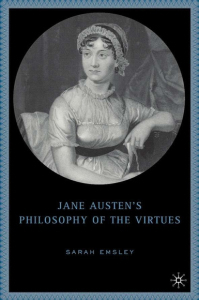 Lit-Lass is reading my book Jane Austen’s Philosophy of the Virtues and writing about it at Frigate to Utopia. She likes it so much she quotes Bronson Alcott saying of The Pilgrim’s Progress that “This is one of the few books that showed me to myself,” and says she feels the same about my book. What an honour to be in such company!
Lit-Lass is reading my book Jane Austen’s Philosophy of the Virtues and writing about it at Frigate to Utopia. She likes it so much she quotes Bronson Alcott saying of The Pilgrim’s Progress that “This is one of the few books that showed me to myself,” and says she feels the same about my book. What an honour to be in such company!
Thanks to Rohan Maitzen of Novel Readings for calling my attention to this series of posts (and, of course, for being a fantastic advisor way back when I was writing the Ph.D. dissertation that eventually turned into this book…).
Here’s a list of what’s appeared so far in the series:
Jane Austen’s Philosophy of the Virtues (Introduction and Chapter 1)
Jane Austen’s Philosophy of the Virtues (2): Propriety’s Claims on Prudence
Jane Austen’s Philosophy of the Virtues (3): Sense and Sensibility
“Pride and Prejudice and the Beauty of Justice”
“Fanny Price and the Contemplative Life”
“Learning the Art of Charity in Emma”
Edited August 11, 2013 to add the last two:
“Balancing the Virtues in Persuasion“







